

This is the front page for our saxophone
items and is where saxphone books (and saxophone jazz books) are
listed.
Click the drop down menus under the Saxophone menu
for Music, CDs, Play Along CDs, and Videos. The jazz books are below
the main listing.
These books are in order by title.
You may search for a title, author, or any
other text on this page by using the
Edit menu Find command (shortcut Ctrl+F or
Mac Command+F).
Books marked "New!" in gold type are new publications.
Books marked "New!" in teal type are new to our stock.
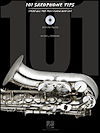 |
S1241: 101 Saxophone Tips by Eric J. Morones. Hal Leonard, 2004, PB, 53 pages + CD. This book presents valuable how-to insight that saxophone players of all styles and levels can benefit from. The text, photos, music, diagrams, and accompanying CD provide a terrific, easy-to-use resource for a variety of topics, including: techniques; maintenance; equipment; practicing; recording; and performance. While many of the tips will be of value to players of all types of music the examples on the CD are primarily about the jazz tips. Click on the cover image to view the table of contents. |
|
 |
S002: The Art of Saxophone Playing by Larry
Teal. Summy-Birchard.
1963. SS, 111 pages. A comprehensive guide to the saxophone. Subjects
include the instrument, the mouthpiece, the reed, playing position,
breathing
technique, the embouchure, tone quality, vibrato, intonation,
developing
technique, attack and release, phrasing and interpretation, doubling,
the
altissimo register, and selected literature. We also have the author's The Saxophonist's Manual which covers many of these concepts in briefer fashion and is more suitable for use during lessons. |
|
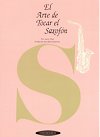 |
S012: El Arte de Tocar el Saxofón por Larry Teal, traducido por Raúl Guiterrez. Summy-Birchard, 1997. SS, 111 pages. Spanish translation of The Art of Saxophone Playing. Overstock Special while supplies last. Regular price is $19.95. | |
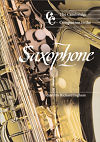 |
S003: The Cambridge Companion to the Saxophone by Richard Ingham. Cambridge University Press, 1998. PB, 225 pages. This is the first comprehensive guide to the saxophone, its history, technical development and repertoire. Contents: invention and development (Thomas Liley), in the twentieth century (Don Ashton), influential soloists (Thomas Dryer-Beers), the repertoire heritage (Thomas Liley), the saxophone quartet (Richard Ingham), the mechanics of playing the saxophone (three chapters), the professional player (three chapters), jazz and the saxophone (Richard Ingham), rock and the saxophone (Richard Ingham and John Helliwell), the saxophone today (two chapters), and teaching the saxophone (Kyle Horch). | |
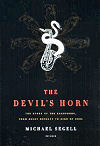 |
S242: The Devil's Horn by Michael Segell. Farrar, Straus and Giroux, 2006, PB, 324 pages. Subtitled The Story of the Saxophone, from Noisy Novelty to the King of Cool, this book traces the 160-year history of the saxophone-a horn that created a sound never before heard in nature, and that from the moment it debuted has aroused both positive and negative passions among all who hear it. Segell outlines the saxophone's fascinating history while he highlights many of its legendary players, including Benny Carter, Illinois Jacquet, Sonny Rollins, Lee Konitz, Phil Woods, Branford Marsalis, and Michael Brecker. The Devil's Horn explores the saxophone's intersections with social movement and change, the innovative acoustical science behind the instrument, its struggles in the world of "legit" music, and the mystical properties that seduce all who fall under its influence. Colorful, evocative, and richly informed, The Devil's Horn is an ingenious portrait of one of the most popular instruments in the world. | |
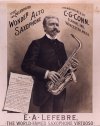 |
S031: E.A. Lefebre: Preeminent Saxophonist of the Nineteenth Century by James R. Noyes. Doctoral dissertation, 2000, SB, 293 pages. The career of Edward A. Lefebre (1834-1911) is one of the most meaningful and substantial in the history of the saxophone. His monumental efforts to popularize the saxophone were felt, first in Europe and Africa, and eventually in the United States. He was a member of the Gilmore and Sousa bands and worked with C.G. Conn to improve the saxophone. This book covers his life and work in detail. | |
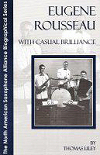 |
S701: Eugene Rousseau: With Casual Brilliance by Thomas Liley. North American Saxophone Alliance, 2011, PB, 231 pages. Thomas Liley, presents the life and pedagogy of the internationally famous saxophone performer and teacher Eugene Rousseau (1932-). In addition to drawing on written sources for this book, the author has used his personal observations and the notes he has made since first meeting Rousseau in 1968. | |
 |
 S009: Jean-Marie Londeix
Master of the Modern
Saxophone by James C. Umble with Herve Corbe, Willam H. Street
(Editorial Consultant), and Michele Gingras; Second Edition. Roncorp,
2021, PB,
666 pages. Jean-Marie Londeix (1932-) is a pioneer of the modern
classical
saxophonist. Many compositions are written for him, and he is one of
the most well-known classical saxophonists of the 20th and 21st
centuries. This book is not only a biography, but has essays and
discussions of how he played some of the most famous works written for
the saxophone. The book is written in both English and French. S009: Jean-Marie Londeix
Master of the Modern
Saxophone by James C. Umble with Herve Corbe, Willam H. Street
(Editorial Consultant), and Michele Gingras; Second Edition. Roncorp,
2021, PB,
666 pages. Jean-Marie Londeix (1932-) is a pioneer of the modern
classical
saxophonist. Many compositions are written for him, and he is one of
the most well-known classical saxophonists of the 20th and 21st
centuries. This book is not only a biography, but has essays and
discussions of how he played some of the most famous works written for
the saxophone. The book is written in both English and French. |
|
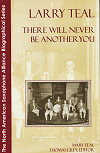 |
S474: Larry Teal: There
Will Never Be Another You by
Mary Teal, Thomas Liley editor. North American Saxophone Alliance,
2008, PB, 262 pages. This book traces the life of the Larry Teal
(1905-1984), the first university professor of saxophone in the United
States. The biography follows Larry Teal’s career from vaudeville, the
popular music of the 1920s, theater and radio orchestras, and the
Detroit Symphony Orchestra through his groundbreaking tenure at the
University of Michigan. Teal’s relationship with Bernhard Heiden, who
wrote his famous Sonata for him is discussed, as well as Teal’s
historic performances of Glazounov’s Concerto and the Concertino da
Camera by Ibert.
The soft cover book is 272 pages in length and is generously
illustrated with 24 photographs. It provides a window to the history of
the saxophone in the United States and how it was influenced by one of
the instrument's most significant teachers. |
|
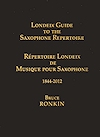 |
S995: Londeix Guide to the
Saxophone Repertoire
1844-2012 edited by Bruce Ronkin. Roncorp Publications, 2012,
HB, 776 pages. The latest version of this book is 130 pages
longer than the previous edition. It is in French and English. More
than 29,000 works for saxophone from 1844 to 2012–the entire lifespan
of the saxophone–are cross-indexed by composer and instrumentation.
Each entry includes valuable information: title, duration, year of
composition, publisher, arranger, dedicatee, movement titles, and
biographical and stylistic information about the composer. Appendices
include addresses of publishers and composers. This publication indexes
all works listed in the previous four editions (1971, 1985, 1994, and
2003), as well as thousands of new titles. It is an indispensable
reference guide for all libraries and saxophonists.
|
|
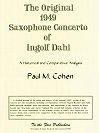 |
S035: The Original 1949 Saxophone Concerto of Ingolf
Dahl by
Paul M. Cohen. To the Fore Publishers, 1985. PB, 156 pages. Paul
Cohen's
definitive dissertation on the origin and history of the original
(1949)
version of the Concerto for Alto Saxophone, including correspondence
with
between Sigurd Rascher and Dahl, notes and sketches, history of the
revisions,
the relationship to the Sinfonietta for Concert Band, and a comparison
of the
original
version to the published version. We have the current edition of
this Concerto with a piano reduction. |
|
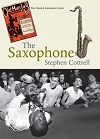 |
 S1170:
The Saxophone by
Stephen Cottrell. Yale University Press, 2012, HB, 412 pages. Stephen
Cottrell (1962-) is a saxophonist and professor of music at City
University London. In the first fully comprehensive study of one of the
world’s most iconic musical instruments, Stephen Cottrell examines the
saxophone’s various social, historical, and cultural trajectories, and
illustrates how and why this instrument, with its idiosyncratic shape
and sound, became important for so many different music-makers around
the world. The chapters are: 1. The life and times of Adolphe
Sax, 2. The saxophone family, 3. The saxophone in the nineteenth
century, 4. Early twentieth-century light and popular music, 5. The
saxophone in jazz, 6. The classical saxophone, 7. Modernism and post
modernism, and 8. The saxophone as a symbol and icon. Many
illustrations. Because of the
weight
of this book,
Media Mail shipping charges will be based on the actual cost of
postage. New Lower Price! Was $84.95. S1170:
The Saxophone by
Stephen Cottrell. Yale University Press, 2012, HB, 412 pages. Stephen
Cottrell (1962-) is a saxophonist and professor of music at City
University London. In the first fully comprehensive study of one of the
world’s most iconic musical instruments, Stephen Cottrell examines the
saxophone’s various social, historical, and cultural trajectories, and
illustrates how and why this instrument, with its idiosyncratic shape
and sound, became important for so many different music-makers around
the world. The chapters are: 1. The life and times of Adolphe
Sax, 2. The saxophone family, 3. The saxophone in the nineteenth
century, 4. Early twentieth-century light and popular music, 5. The
saxophone in jazz, 6. The classical saxophone, 7. Modernism and post
modernism, and 8. The saxophone as a symbol and icon. Many
illustrations. Because of the
weight
of this book,
Media Mail shipping charges will be based on the actual cost of
postage. New Lower Price! Was $84.95. |
|
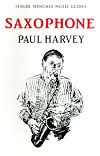 |
S011: Saxophone by Paul Harvey. Kahn & Averill, London, 1995, PB, 149 pages. A very useful reference book on the saxophone. It includes history, the saxophone family, parts of the saxophone, fingering, tone production, special effects, doubling, repertoire (orchestral, quartet, and solo), methods, influential saxophonists, discography, unusual saxophones, and the saxophone today. | |
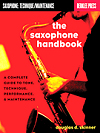 |
S958: The Saxophone Handbook by Douglas D. Skinner. Berklee Press, 2013, PB, 90 pages. A complete guide to playing and maintenance, this handbook offers essential information on all dimensions of the saxophone. It provides an overview of technique, such as breathing, fingerings, articulations, and more. Exercises will help you develop your sense of timing, facility, and sound. Extensive directions (with illustrations) on repairs will help you maintain your instrument and customize it to support your own playing style and preferences. You'll learn to fine-tune your reed, recork the keys, fix binding keys, replace pads, and many other repairs and adjustments. You'll also learn to improve your tone, intonation, and flexibility while playing with proper technique. While saxophone repair is only one of five chapters in this book, it does an excellent job of covering basic repairs and adjustments. | |
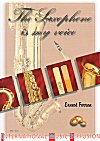 |
S060: The Saxophone Is My Voice by Ernest Ferron translated from the French by Jacqueline Rose. International Music Diffusion, 1997, PB, 117 pages. Ernest Ferron has drawn from his experience as a master instrument maker and from his contact with leading instrumentalists to produce a synthesis of his knowledge. The first 48 pages covers how a saxophone functions with details on Adolphe Sax's parabola, the neck, bow, tone holes, bell, mouthpiece, reeds, and tuning. The rest of the book is on the tools and techniques of saxophone repair and adjustment. | |
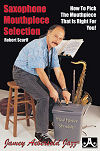 |
WW026: Saxophone Mouthpiece
Selection by Robert Scarff. Jamey Aebersold Jazz, 2006, SB,
88 pages. This book contains information on mouthpiece parts and
design,
guidelines in selecting a mouthpiece for the type of sound you need,
facing
charts for commercial saxophone and clarinet mouthpieces, and chamber
designations
of some representative brands of saxophone mouthpieces. This book also
includes guidance on reed adjustments, some maintenance tips, and some
musician jokes. While this book is primarily oriented toward the
saxophonist,
clarinetists will also find useful information here. |
|
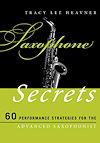 |
 S1272:
Saxophone Secrets, 60 Performance Strategies for the Advanced
Saxophonist
by
Tracy Lee Heavner. Scarecrow Press, 2013, PB, 152 pages. Tracy
Heavner’s Saxophone Secrets provides advanced saxophonists with 60
performance secrets that will assist in their musical development. This
work is the result of 30 years of personal teaching and performance
experience. Heavner offers both intermediate players and advanced
professionals a wide variety of techniques, which will greatly improve
any saxophonist’s performance ability. Click on the cover
image to view the table of contents. S1272:
Saxophone Secrets, 60 Performance Strategies for the Advanced
Saxophonist
by
Tracy Lee Heavner. Scarecrow Press, 2013, PB, 152 pages. Tracy
Heavner’s Saxophone Secrets provides advanced saxophonists with 60
performance secrets that will assist in their musical development. This
work is the result of 30 years of personal teaching and performance
experience. Heavner offers both intermediate players and advanced
professionals a wide variety of techniques, which will greatly improve
any saxophonist’s performance ability. Click on the cover
image to view the table of contents. |
|
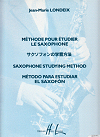 |
S400: Saxophone Studying Method
by Jean-Marie Londeix. Lemoine, 1997, SB, 85 pages. This is not a
method book in the conventional sense, but instead is a guide and text
book for studying the saxophone. It is in four languages: French,
Japanese, English and Spanish, each in their own vertical column. There
are many specific references to books of study and saxophone
repertoire. Subjects covered include basic techniques and equipment,
etudes, and literature (both orchestral and solo). A very detailed book
with many diagrams and musical examples. |
|
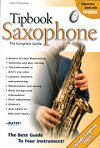 |
S017: Tipbook Saxophone
by Hugo Pinksterboer. The Tipbook
Company, 2007, PB, 216 pages. A new and much longer edition of this
interesting and well illustrated book that focuses on saxophone
construction, selection and maintenance (including mouthpieces and
reeds), resources for learning to play, and a fingering chart. It also
has links to more information on the Internet. This book will be of
interest to adult and teenage beginners and the parents of younger
students. It will also be useful for band directors and music education
students who aren't woodwind specialists. |
|
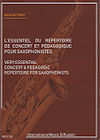 |
 S1298: Very Essential
Concert & Pedagogic Repertoire for Saxophonists
by
Nicolas Prost, International Music Diffusion, 2018, PB, 158 pages.
French saxophonist Nicolas Proust has compiled this detailed work which
covers a major portion of the saxophone repertoire including methods,
studies, solos, ensembles chamber music and the saxophone and the
saxophone in the orchestra. See the table of contents for the
categories. Click
on the cover image to view Table of Contents. S1298: Very Essential
Concert & Pedagogic Repertoire for Saxophonists
by
Nicolas Prost, International Music Diffusion, 2018, PB, 158 pages.
French saxophonist Nicolas Proust has compiled this detailed work which
covers a major portion of the saxophone repertoire including methods,
studies, solos, ensembles chamber music and the saxophone and the
saxophone in the orchestra. See the table of contents for the
categories. Click
on the cover image to view Table of Contents. |
|
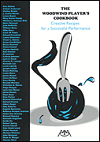 |
WW179: The Woodwind Player's
Cookbook edited by
Charles West. Meredith Music, 2008, PB, 178 pages. Subtitled Creative Recipes for a Successful
Performance, this valuable collection of quick-to-read yet
deeply insightful strategies is like finding expert trade secrets all
placed in one convenient source. With outstanding records of
performance, workshop clinics, recordings, research, composition,
leadership and teaching, the 57 authors provide their favorite
“recipes” that range from overviews of successful programs to specific
topics that will inspire all levels and types of ensembles and
performers. Sample “recipes” include: Developing Facility on the Bass
Clarinet (J. Lawrie Bloom), Breathing Demystified (Leone Buyse), Recipe
for Preventing Play-Related Health Problems (William J. Dawson, M.D.),
How Should I Test a Saxophone Mouthpiece? (Eugene Rousseau), and many
more. Click
on the cover image to view Table of Contents. |
|
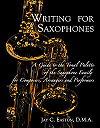 |
S684: Writing for Saxophones
by Jay C. Easton. Baxter Music Publishing, 2006, SB, 302 pages + CD.
Subtitled A Guide to the Tonal
Palette of the Saxophone Family for Composers, Arrangers and Performers,
this is a practical guide to
understanding and effectively utilizing the sounds of this instrumental
group as it advances into the twenty-first century. Over ninety printed
solo and ensemble examples in the book have been recorded on the
enclosed audio CD, which allows the reader to explore the distinct
personalities of the various saxophones and integrate their individual
musical characteristics into his or her tonal imagination. Saxophone
performers and enthusiasts will find enjoyment and edification within
these pages, and composers and arrangers who wish to explore the many
possibilities offered by the saxophone family will find this book to be
an especially valuable resource. Because of the weight of this book, Media Mail (bookrate) shipping charges will be based on the actual cost of postage. |
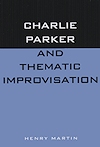 |
S014: Charlie Parker and Thematic Improvisation by Henry Martin. Scarecrow Press, 2001, PB, 156 pages. Martin provides a new overall assessment of the importance of Charlie Parker through an analysis of his improvisations in a variety of genres. Earlier studies of Parker argue that his style is based on an extensive network of melodic formulas that are combined to create solos. Because the same formulas appear throughout his improvisations regardless of the theme, these studies concluded that the solos do not usually relate to the original melodies. This book provides a much needed reassessment by showing that Parker's solos are often related to the original themes in unexpected and sometimes ingenious ways. The conclusion sums up features of Parker's style and discusses his contribution in the context of Western music history. Numerous transcriptions (in concert key) are provided. This groundbreaking technical study will be of interest to musicologists and serious students of jazz. | |
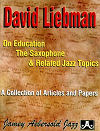 |
S297: David Liebman: On Education, The Saxophone & Related Jazz Topics by David Liebman. Jamey Aebersold Jazz, 2003, SS, 51 pages. Here is a masterful collection of articles and papers written over the years summarizing thoughts on various topics related to jazz and education such as his educational concepts, jazz rhythm, the soprano saxophone, principles of breathing, playing solo saxophone, concerns for beginning saxophonists, and his personal view on what jazz means.. Each article is a worthy testament unto itself, but as a collection, they form an enlightening and insightful tool for every music educator and player in search of new ideas and fresh perspectives on teaching for the next century. | |
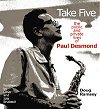 |
S088: Take Five, The Public and Private Lives of Paul Desmond by Doug Ramsey. Parkside Publications, 2005, HB, 372 pages. Take Five: The Public and Private Lives of Paul Desmond is the story of a jazz artist who transcended genres to establish one of the most immediately recognizable sounds in all of music. It includes long, revealing passages from Paul's letters, hilarious accounts of life in the army and life on the road, his memos to himself about his artistic choices and his disagreements with jazz orthodoxy, his carefully crafted campaign to persuade Brubeck that he should be in Dave's band. Many of the book's nearly two hundred photographs have never before been published. Ramsey includes the story of how Brubeck's friendship with Desmond blew up and Brubeck's wry account of how Desmond repaired it. Dave and Iola Brubeck wrote the book's foreword. It begins, "Paul Desmond was an enigma." This fascinating book makes him less of one. Take Five also includes transcriptions of several of Paul's most brilliant recorded solos. It is luxuriously produced in large (10 x 11 inches) format on fine matte paper. The book is extensively illustrated with 190 photographs, most of which have never been previously published. Take Five contains 372 pages, end notes, an index and a complete Paul Desmond discography. This book is out of print. You can buy a version for kindle or see what is available in the secondary market on Amazon. | |
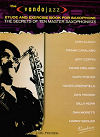 |
S321: The Vandojazz Etude and
Exercise Book for Saxophone. Carl Fischer, 2007, PB, 120 pages.
Subtitled: The Secrets of Ten Master Saxophonists. This new book
contains etudes, exercises, scales, chords, and strategies for
improvisation as well as the philosophy and explanation of what is in
each chapter. The saxophonists are Don Aliquo, Frank Catalano, Jeff
Coffin, Denis Diblasio, Gary Foster (go Gary!), Hayes Greenfield, Dan
Higgins, Billy Kerr, Dan Moretti, and Harry Skoler. While this book is
mostly music, we thought it included enough text to list in this
section. |
Bindings: HB: Hard Bound, PB: Perfect Bound (paperback with square spine), SS: Saddle Stitch (paper, folded and stapled), SB: Spiral Bound (plastic or metal)